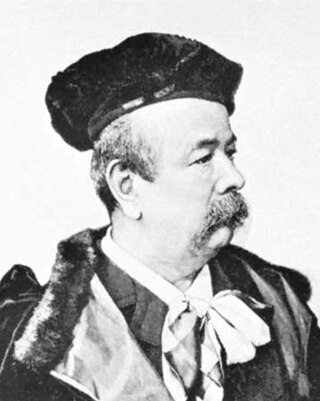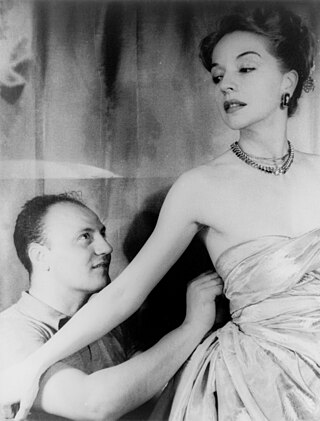Related Research Articles

DoñaMaría Eugenia Ignacia Agustina de Palafox y Kirkpatrick, 19th Countess of Teba, 16th Marchioness of Ardales, known as Eugénie de Montijo, was Empress of the French from her marriage to Emperor Napoleon III on 30 January 1853 until the Emperor was overthrown on 4 September 1870. From 28 July to 4 September 1870, she was the de facto head of state of France.

Victorian fashion consists of the various fashions and trends in British culture that emerged and developed in the United Kingdom and the British Empire throughout the Victorian era, roughly from the 1830s through the 1890s. The period saw many changes in fashion, including changes in styles, fashion technology and the methods of distribution. Various movement in architecture, literature, and the decorative and visual arts as well as a changing perception of gender roles also influenced fashion.

A crinoline is a stiff or structured petticoat designed to hold out a skirt, popular at various times since the mid-19th century. Originally, crinoline described a stiff fabric made of horsehair ("crin") and cotton or linen which was used to make underskirts and as a dress lining. The term crin or crinoline continues to be applied to a nylon stiffening tape used for interfacing and lining hemlines in the 21st century.

Charles Frederick Worth was an English fashion designer who founded the House of Worth, one of the foremost fashion houses of the 19th and early 20th centuries. He is considered by many fashion historians to be the father of haute couture. Worth is also credited with revolutionising the business of fashion.

A dressmaker, also known as a seamstress, is a person who makes clothing for women, such as dresses, blouses, and evening gowns. Dressmakers were historically known as mantua-makers, and are also known as a modiste or fabrician.

1850s fashion in Western and Western-influenced clothing is characterized by an increase in the width of women's skirts supported by crinolines or hoops, the mass production of sewing machines, and the beginnings of dress reform. Masculine styles began to originate more in London, while female fashions originated almost exclusively in Paris.

Valerie Fahnestock Steele is an American fashion historian, curator, and director of the Museum at the Fashion Institute of Technology. Steele has written more than eight books on the history of fashion, and can be regarded as one of the pioneers in the study of fashion. She was appointed director of the museum in 2003.

Suzy Peta Menkes is a British journalist and fashion critic. Formerly the fashion editor for the International Herald Tribune, Menkes also served as editor, Vogue International, for 25 international editions of Vogue online until October 2020.

History of fashion design refers specifically to the development of the purpose and intention behind garments, shoes ,accessories, and their design and construction. The modern industry, based around firms or fashion houses run by individual designers, started in the 19th century with Charles Frederick Worth who, beginning in 1858, was the first designer to have his label sewn into the garments he created.

Fashion from 1910 to 1919 in the Western world was characterized by a rich and exotic opulence in the first half of the decade in contrast with the somber practicality of garments worn during the Great War. Men's trousers were worn cuffed to ankle-length and creased. Skirts rose from floor length to well above the ankle, women began to bob their hair, and the stage was set for the radical new fashions associated with the Jazz Age of the 1920s.

Fashion in France is an important subject in the culture and country's social life, as well, being an important part of its economy.

The Palais Galliera, also formally known as the Musée de la Mode de la Ville de Paris, and formerly known as Musée Galliera, is a museum of fashion and fashion history located at 10, avenue Pierre 1er de Serbie, in the 16th arrondissement of Paris, France. When exhibitions are on it is open daily except Mondays and public holidays; an admission fee is charged and varies depending on the exhibition programmed. The museum opened its doors again 28 September 2013 after being closed for major renovation.

The sack-back gown or robe à la française was a women's fashion of 18th century Europe. At the beginning of the century, the sack-back gown was a very informal style of dress. At its most informal, it was unfitted both front and back and called a sacque, contouche, or robe battante. By the 1770s the sack-back gown was second only to court dress in its formality. This style of gown had fabric at the back arranged in box pleats which fell loose from the shoulder to the floor with a slight train. In front, the gown was open, showing off a decorative stomacher and petticoat. It would have been worn with a wide square hoop or panniers under the petticoat. Scalloped ruffles often trimmed elbow-length sleeves, which were worn with separate frills called engageantes.

Caroline Reboux was a Parisian milliner and French fashion designer. She opened her first boutique at 23 rue de la paix in Paris in 1865, which she continued to operate throughout her life. Reboux opened other shops in Paris and London starting in 1870. She trained other milliners who became famous in their own right, including American milliner Lilly Daché and French milliner Rose Valois. Reboux's most famous shop was located at 9 Avenue Matignon in Paris, which carried on operating after her death for almost three decades under the direction of Lucienne Rabaté known as "Mademoiselle Lucienne" the most famous parisian milliner at that time.

A Eugénie hat is a small women's hat that is usually worn tilted forwards over the face, or it may be angled low over one eye. Typically, it is made of velvet or felt, although a variety of materials may be used. The classic design also has a plume of feathers, although other trims may be used.
Louis Hippolyte Leroy (1763–1829) was a French fashion merchant who founded the House of Leroy, one of the foremost fashion houses of the early 19th century First Empire Paris. He is known as the favorite fashion trader and the official fashion designer of empress Josephine de Beauharnais. He was very successful and also provided dresses for several other royal and Princely courts in Europe during the early 19th century.
Madame Victorine (19th-century), was a French fashion designer couturier.
Madame Vignon also known as Madame Vignon-Chauvin, was a French fashion designer Couturier.
Madame Virot (1826-1911) was a French fashion designer milliner. Alongside Caroline Reboux, she was one of the two most famous hat designers in Paris during the second half of the 19th-century.

A fashion icon or fashion leader is a influential person who introduces new styles which spread throughout fashion culture and become part of fashion. They initiate a new style which others may follow. They may be famous personalities such as political leaders, celebrities, or sports personalities. For example, during the 1960s, Jackie Kennedy was a great fashion icon for American women, and her style became a sign of wealth, power, and distinction; and her famous Pink Chanel suit is one of the most referenced and revisited of all of her items of clothing. Twiggy was an It girl, she was a teenaged model and fashion icon of Swinging Sixties.
References
- ↑ Valerie Steele: Women of Fashion: Twentieth-century Designers, Rizzoli International, 1991
- ↑ Napoléon III et la reine Victoria: une visite à l'Exposition universelle de 1855 : Musée national du château de Compiègne, 4 octobre 2008-19 janvier 2009
- ↑ L'intermédiaire des chercheurs et curieux. Benj. Duprat, Libraire de l'Institut, 1912
- ↑ Granström, Alvar, (in Swedish) Kvinnor och krinoliner: en mode- och sedeskildring från krinolinmodets tid ['Women and crinolines: a depiction of fashion and customs in the crinoline period'], Carlsson, Stockholm, 1990
- ↑ James Laver: Manners and Morals in the Age of Optimism, 1848-1914, 1966
- ↑ Valerie Steele: Women of Fashion: Twentieth-century Designers, Rizzoli International, 1991